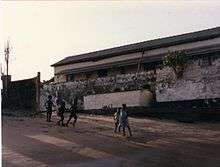Fort Prinzenstein




Fort Prinzenstein (Danish: Fort Prinsensten) is a fort located at Keta, Ghana which was used in the slave trade.[1] Many such forts were built in Africa, but Prinzenstein is one of the few that lie east of the Volta River.[1] It was initially built by Danish traders in 1784 for defensive purposes in a war against the Anlo Ewe and to keep the area safe from other colonial powers.[2]
History
The Dutch West India Company had built Fort Singelenburgh at the site of the current fort in 1734, but the Dutch abandoned the fort in 1737, probably because of the Dutch siding with the defeated Akwamu in the Akyem-Akwamu conflict.[3] The Danish had developed a presence in Keta, the commercial capital of the Anlo people. However, in 1783 when the Anlo people pillaged the local Danish agent, the Governor of Christiansborg raised an army drawn from people with a tradition of antipathy towards the Anlo: the Ada, Akwapim, Ga and Krobo. The Danes were thus able to defeat the Anlo and impose a treaty in 1784 which allowed them to build Fort Prinzenstein and obliged the Anlo to trade only with them.
Up until 1803 the fort was used as a dungeon for slaves awaiting transportation to the Caribbean. In 1850 the fort, along with the rest of the Danish Gold Coast was sold to Britain.[4] The fort was used as a prison for a period before it was partially destroyed by the sea in 1980.[5] The remains of the fort are now visited by tourists.[6]
Present Fort
The remains of the fort. (September, 2012)
References
- 1 2 ghanatourism.gov.gh
- ↑ unesco.no. Some sources say 1780.
- ↑ Albert van Dantzig (1999) (in German), Forts and Castles of Ghana, Accra: Sedco Publ., ISBN 9964-72-010-6
- ↑ worldstatesmen.org
- ↑ unesco.no
- ↑ Ghana Consulate-General, New York
Coordinates: 5°55′18″N 0°59′37″E / 5.92167°N 0.99361°E